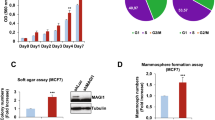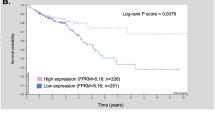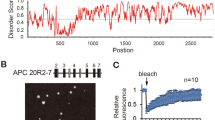Abstract
Mutation of APC (adenomatous polyposis coli) is a common factor in most colorectal cancers. APC has many functions, the most prominent is its capacity to regulate β-catenin-mediated gene transcription in response to Wnt signalling. Loss of APC leads to deregulated β-catenin and this is intimately linked with tumour formation. However, recent evidence indicates that the interaction of APC with the cytoskeleton might also contribute to tumour initiation and progression. How does APC interact with the cytoskeleton and how could this play a part in colorectal tumorigenesis?
This is a preview of subscription content, access via your institution
Access options
Subscribe to this journal
Receive 12 print issues and online access
$209.00 per year
only $17.42 per issue
Buy this article
- Purchase on Springer Link
- Instant access to full article PDF
Prices may be subject to local taxes which are calculated during checkout




Similar content being viewed by others
References
Moser, A. R., Dove, W. F., Roth, K. A. & Gordon, J. I. The Min (multiple intestinal neoplasia) mutation: its effect on gut epithelial cell differentiation and interaction with a modifier system. J. Cell Biol. 116, 1517–1526 (1992).
Su, L. K. et al. Multiple intestinal neoplasia caused by mutations in the murine homolog of the APC gene. Science 256, 668–670 (1992).
Fodde, R. The APC gene in colorectal cancer. Eur. J. Cancer 38, 867–871 (2002).
Gregorieff, A. & Clevers, H. Wnt signaling in the intestinal epithelium: from endoderm to cancer. Genes Dev. 19, 877–890 (2005).
Pinto, D. & Clevers, H. Wnt control of stem cells and differentiation in the intestinal epithelium. Exp. Cell Res. 306, 357–363 (2005).
Bienz, M. & Clevers, H. Linking colorectal cancer to Wnt signaling. Cell 103, 311–320 (2000).
Dikovskaya, D., Zumbrunn, J., Penman, G. A. & Näthke, I. S. The adenomatous polyposis coli protein: in the limelight out at the edge. Trends Cell Biol. 11, 378–384 (2001).
Näthke, I. S. The adenomatous polyposis coli protein: the Achilles heel of the gut epithelium. Annu. Rev. Cell Dev. Biol. 20, 337–366 (2004).
Samowitz, W. S. et al. β-Catenin mutations are more frequent in small colorectal adenomas than in larger adenomas and invasive carcinomas. Cancer Res. 59, 1442–1444 (1999).
Haigis, K. M. et al. Tumor regionality in the mouse intestine reflects the mechanism of loss of Apc function. Proc. Natl Acad. Sci. USA 101, 9769–9773 (2004).
Harada, N. et al. Lack of tumorigenesis in the mouse liver after adenovirus-mediated expression of a dominant stable mutant of β-catenin. Cancer Res. 62, 1971–1977 (2002).
Gounari, F. et al. Loss of adenomatous polyposis coli gene function disrupts thymic development. Nature Immunol. 6, 800–809 (2005).
Cheng, H. & Leblond, C. P. Origin, differentiation and renewal of the four main epithelial cell types in the mouse small intestine. V. Unitarian Theory of the origin of the four epithelial cell types. Am. J. Anat. 141, 537–561 (1974).
Cheng, H. & Leblond, C. P. Origin, differentiation and renewal of the four main epithelial cell types in the mouse small intestine. I. Columnar cell. Am. J. Anat. 141, 461–479 (1974).
Stappenbeck, T. S., Wong, M. H., Samm, J. R., Mysorekar, I. U. & Gordon, J. I. Notes from some crypt watchers: regulation of renewal in the mouse intestinal epithelium. Curr. Opin. Cell Biol. 10, 702–709 (1998).
Kaur, P. & Potten, C. S. Cell migration velocities in the crypts of the small intestine after cytotoxic insult are not dependent on mitotic activity. Cell. Tissue Kinet. 19, 601–610 (1986).
Kaur, P. & Potten, C. S. Circadian variation in migration velocity in small intestinal epithelium. Cell. Tissue Kinet. 19, 591–599 (1986).
Bullen, T. F. et al. Characterization of epithelial cell shedding from human small intestine. Lab. Invest. 86, 1052–1063 (2006).
Kim, S. H., Roth, K. A., Moser, A. R. & Gordon, J. I. Transgenic mouse models that explore the multistep hypothesis of intestinal neoplasia. J. Cell Biol. 123, 877–893 (1993).
Sansom, O. J. et al. Loss of Apc in vivo immediately perturbs Wnt signaling, differentiation, and migration. Genes Dev. 18, 1385–1390 (2004).
Munemitsu, S. et al. The APC gene product associates with microtubules in vivo and promotes their assembly in vitro. Cancer Res. 54, 3676–3681 (1994).
Su, L.-K. et al. APC binds to the novel protein EB1. Cancer Res. 55, 2972–2977 (1995).
Tirnauer, J. S. & Bierer, B. E. EB1 proteins regulate microtubule dynamics, cell polarity, and chromosome stability. J. Cell Biol. 149, 761–766 (2000).
Matsumine, A. et al. Binding of APC to the human homologue of the Drosophila discs large tumor suppressor protein. Science 272, 1020–1023 (1996).
Zumbrunn, J., Inoshita, K., Hyman, A. A. & Näthke, I. S. Binding of the adenomatous polyposis coli protein to microtubules increases microtubule stability and is regulated by GSK3b phosphorylation. Curr. Biol. 11, 44–49 (2001).
Kita, K., Wittmann, T., Nä thke, I. S. & Waterman- Storer, C. M. APC on microtubule plus ends in cell extensions can promote microtubule net growth with or without EB1. Mol. Biol. Cell 17, 2331–2345 (2006).
Näthke, I. S., Adams, C. L., Polakis, P., Sellin, J. H. & Nelson, W. J. The adenomatous polyposis coli tumor suppressor protein localizes to plasma membrane sites involved in active cell migration. J. Cell Biol. 134, 165–179 (1996).
Mimori-Kiyosue, Y., Shiina, N. & Tsukita, S. Adenomatous polyposis coli (APC) protein moves along microtubules and concentrates at their growing ends in epithelial cells. J. Cell Biol. 148, 505–517 (2000).
Langford, K. J., Askham, J. M., Lee, T., Adams, M. & Morrison, E. E. Examination of actin and microtubule dependent APC localisations in living mammalian cells. BMC Cell Biol. 7, 3 (2006).
Reilein, A. & Nelson, W. J. APC is a component of an organizing template for cortical microtubule networks. Nature Cell Biol. 7, 463–473 (2005).
Reilein, A., Yamada, S. & Nelson, W. J. Self-organization of an acentrosomal microtubule network at the basal cortex of polarized epithelial cells. J. Cell Biol. 171, 845–855 (2005).
Rosin-Arbesfeld, R., Ihrke, G. & Bienz, M. Actin-dependent membrane association of the APC tumour suppressor in polarized mammalian epithelial cells. EMBO J. 20, 5929–5939 (2001).
Watanabe, T. et al. Interaction with IQGAP1 links APC to Rac1, Cdc42, and actin filaments during cell polarization and migration. Dev. Cell 7, 871–883 (2004).
Kawasaki, Y. et al. Asef, a link between the tumor suppressor APC and G-protein signaling. Science 289, 1194–1197 (2000).
Kawasaki, Y., Sato, R. & Akiyama, T. Mutated APC and Asef are involved in the migration of colorectal tumour cells. Nature Cell Biol. 5, 211–215 (2003).
Jimbo, T. et al. Identification of a link between the tumour suppressor APC and the kinesin superfamily. Nature Cell Biol. 4, 323–327 (2002).
Li, Z. & Näthke, I. S. Tumor-associated NH2-terminal fragments are the most stable part of the adenomatous polyposis coli protein and can be regulated by interactions with COOH-terminal domains. Cancer Res. 65, 5195–5204 (2005).
Funke, L., Dakoji, S. & Bredt, D. S. Membrane-associated guanylate kinases regulate adhesion and plasticity at cell junctions. Annu. Rev. Biochem. 74, 219–245 (2005).
Zhou, F. Q., Zhou, J., Dedhar, S., Wu, Y. H. & Snider, W. D. NGF-induced axon growth is mediated by localized inactivation of GSK-3β and functions of the microtubule plus end binding protein APC. Neuron 42, 897–912 (2004).
Etienne-Manneville, S. & Hall, A. Cdc42 regulates GSK-3β and adenomatous polyposis coli to control cell polarity. Nature 421, 753–756 (2003).
Wen, Y. et al. EB1 and APC bind to mDia to stabilize microtubules downstream of Rho and promote cell migration. Nature Cell Biol. 6, 820–830 (2004).
Iizuka-Kogo, A., Shimomura, A. & Senda, T. Colocalization of APC and DLG at the tips of cellular protrusions in cultured epithelial cells and its dependency on cytoskeletons. Histochem. Cell Biol. 123, 67–73 (2005).
Etienne-Manneville, S., Manneville, J. B., Nicholls, S., Ferenczi, M. A. & Hall, A. Cdc42 and Par6–PKCζ regulate the spatially localized association of Dlg1 and APC to control cell polarization. J. Cell Biol. 170, 895–901 (2005).
Brown, M. D. & Sacks, D. B. IQGAP1 in cellular signaling: bridging the GAP. Trends Cell Biol. 16, 242–249 (2006).
Noritake, J., Watanabe, T., Sato, K., Wang, S. & Kaibuchi, K. IQGAP1: a key regulator of adhesion and migration. J. Cell Sci. 118, 2085–2092 (2005).
Mahmoud, N. N. et al. Apc gene mutation is associated with a dominant-negative effect upon intestinal cell migration. Cancer Res. 57, 5045–5050 (1997).
Wong, M. H., Hermiston, M. L., Syder, A. J. & Gordon, J. I. Forced expression of the tumor suppressor adenomatosis polyposis coli protein induces disordered cell migration in the intestinal epithelium. Proc. Natl Acad. Sci. USA 93, 9588–9593 (1996).
Louie, R. K. et al. Adenomatous polyposis coli and EB1 localize in close proximity of the mother centriole and EB1 is a functional component of centrosomes. J. Cell Sci. 117, 1117–1128 (2004).
Dikovskaya, D., Newton, I. P. & Näthke, I. S. The adenomatous polyposis coli protein is required for the formation of robust spindles formed in CSF Xenopus extracts. Mol. Biol. Cell 15, 2978–2991 (2004).
Kaplan, K. B. et al. A novel role for the APC tumour suppressor in chromosome segregation. Nature Cell Biol. 3, 429–432 (2001).
Fodde, R. et al. Mutations in the APC tumour suppressor gene cause chromosomal instability. Nature Cell Biol. 3, 433–438 (2001).
Banks, J. D. & Heald, R. Adenomatous polyposis coli associates with the microtubule-destabilizing protein XMCAK. Curr. Biol. 14, 2033–2038 (2004).
Green, R. A. & Kaplan, K. B. Chromosome instability in colorectal tumor cells is associated with defects in microtubule plus-end attachments caused by a dominant mutation in APC. J. Cell Biol. 163, 949–961 (2003).
Green, R. A., Wollman, R. & Kaplan, K. B. APC and EB1 function together in mitosis to regulate spindle dynamics and chromosome alignment. Mol. Biol. Cell 16, 4609–4622 (2005).
Tighe, A., Johnson, V. L. & Taylor, S. S. Truncating APC mutations have dominant effects on proliferation, spindle checkpoint control, survival and chromosome stability. J. Cell Sci. 117, 6339–6353 (2004).
Tighe, A., Johnson, V. L., Albertella, M. & Taylor, S. S. Aneuploid colon cancer cells have a robust spindle checkpoint. EMBO Rep. 2, 609–614 (2001).
Draviam, V. M., Shapiro, I., Aldridge, B. & Sorger, P. K. Misorientation and reduced stretching of aligned sister kinetochores promote chromosome missegregation in EB1- or APC-depleted cells. EMBO J. 25, 2814–2827 (2006).
Shi, Q. & King, R. W. Chromosome nondisjunction yields tetraploid rather than aneuploid cells in human cell lines. Nature 437, 1038–1042 (2005).
Fujiwara, T. et al. Cytokinesis failure generating tetraploids promotes tumorigenesis in p53-null cells. Nature 437, 1043–1047 (2005).
Yamashita, Y. M., Jones, D. L. & Fuller, M. T. Orientation of asymmetric stem cell division by the APC tumor suppressor and centrosome. Science 301, 1547–1550 (2003).
Potten, C. S., Owen, G. & Booth, D. Intestinal stem cells protect their genome by selective segregation of template DNA strands. J. Cell Sci. 115, 2381–2388 (2002).
Armakolas, A. & Klar, A. J. Cell type regulates selective segregation of mouse chromosome 7 DNA strands in mitosis. Science 311, 1146–1149 (2006).
Lechler, T. & Fuchs, E. Asymmetric cell divisions promote stratification and differentiation of mammalian skin. Nature 437, 275–280 (2005).
Lane, J. D., Allan, V. J. & Woodman, P. G. Active relocation of chromatin and endoplasmic reticulum into blebs in late apoptotic cells. J. Cell Sci. 118, 4059–4071 (2005).
Moss, D. K., Betin, V. M., Malesinski, S. D. & Lane, J. D. A novel role for microtubules in apoptotic chromatin dynamics and cellular fragmentation. J. Cell Sci. 119, 2362–2374 (2006).
Zhang, T. et al. Evidence that APC regulates survivin expression: a possible mechanism contributing to the stem cell origin of colon cancer. Cancer Res. 61, 8664–8667 (2001).
Chen, T. et al. Regulation of caspase expression and apoptosis by adenomatous polyposis coli. Cancer Res. 63, 4368–4374 (2003).
Zhu, P. et al. Induction of HDAC2 expression upon loss of APC in colorectal tumorigenesis. Cancer Cell 5, 455–463 (2004).
Chen, T. et al. Clusterin-mediated apoptosis is regulated by adenomatous polyposis coli and is p21 dependent but p53 independent. Cancer Res. 64, 7412–7419 (2004).
Steigerwald, K., Behbehani, G. K., Combs, K. A., Barton, M. C. & Groden, J. The APC tumor suppressor promotes transcription-independent apoptosis in vitro. Mol. Cancer Res. 3, 78–89 (2005).
Venesio, T. et al. Germline APC mutation on the β-catenin binding site is associated with a decreased apoptotic level in colorectal adenomas. Mod. Pathol. 16, 57–65 (2003).
Bernal, N. P. et al. Evidence for active Wnt signaling during postresection intestinal adaptation. J. Pediatr. Surg. 40, 1025–1029 (2005).
Hasegawa, S. et al. Apoptosis in neural crest cells by functional loss of APC tumor suppressor gene. Proc. Natl Acad. Sci. USA 99, 297–302 (2002).
Rosenblatt, J., Raff, M. C. & Cramer, L. P. An epithelial cell destined for apoptosis signals its neighbors to extrude it by an actin- and myosin-dependent mechanism. Curr. Biol. 11, 1847–1857 (2001).
Radtke, F. & Clevers, H. Self-renewal and cancer of the gut: two sides of a coin. Science 307, 1904–1909 (2005).
Batlle, E. et al. β-Catenin and TCF mediate cell positioning in the intestinal epithelium by controlling the expression of EphB/ephrinB. Cell 111, 251–263 (2002).
Penman, G. A., Leung, L. & Näthke, I. S. The adenomatous polyposis coli protein (APC) exists in two distinct soluble complexes with different functions. J. Cell Sci. 118, 4741–4750 (2005).
Pollack, A. L., Barth, A. I. M., Altschuler, Y., Nelson, W. J. & Mostov, K. E. Dynamics of β-catenin interactions with APC protein regulate epithelial tubulogenesis. J. Cell Biol. 137, 1651–1662 (1997).
Krylova, O., Messenger, M. J. & Salinas, P. C. Dishevelled-1 regulates microtubule stability: a new function mediated by glycogen synthase kinase-3β. J. Cell Biol. 151, 83–94 (2000).
Krylova, O. et al. WNT-3, expressed by motoneurons, regulates terminal arborization of neurotrophin-3-responsive spinal sensory neurons. Neuron 35, 1043–1056 (2002).
Ciani, L., Krylova, O., Smalley, M. J., Dale, T. C. & Salinas, P. C. A divergent canonical WNT-signaling pathway regulates microtubule dynamics: dishevelled signals locally to stabilize microtubules. J. Cell Biol. 164, 243–253 (2004).
Smits, R. et al. Apc1638T: a mouse model delineating critical domains of the adenomatous polyposis coli protein involved in tumorigenesis and development. Genes Dev. 13, 1309–1321 (1999).
Gaspar, C. & Fodde, R. APC dosage effects in tumorigenesis and stem cell differentiation. Int. J. Dev. Biol. 48, 377–386 (2004).
Lee, A. et al. Detection of tumor markers including carcinoembryonic antigen, APC, and cyclin D2 in fine-needle aspiration fluid of breast. Arch. Pathol. Lab. Med. 128, 1251–1256 (2004).
Beroud, C. & Soussie, T. APC gene: database of germline and somatic mutations in human tumors and cell lines. Nucleic Acids Res. 24, 121–124 (1996).
Fodde, R., Smits, R. & Clevers, H. APC, signal transduction and genetic instability in colorectal cancer. Nature Rev. Cancer 1, 55–67 (2001).
Acknowledgements
I thank all members of my laboratory and A. Müller (University of Dundee) for their constructive comments on the manuscript, with particular thanks to P. Appleton (Näthke laboratory) for creating the images shown in Figure 2. I am grateful to O. Sansom (Beatson Institute) and K. Haigis (Massachusetts Institute of Technology) for helpful discussions. Work in my laboratory is funded by grants from Cancer Research UK, the Association for International Research, The Burroughs Wellcome Fund, and the Human Frontiers Science Programme.
Author information
Authors and Affiliations
Ethics declarations
Competing interests
The author declares no competing financial interests.
Related links
Related links
DATABASES
National Cancer Institute
FURTHER INFORMATION
Rights and permissions
About this article
Cite this article
Näthke, I. Cytoskeleton out of the cupboard: colon cancer and cytoskeletal changes induced by loss of APC. Nat Rev Cancer 6, 967–974 (2006). https://doi.org/10.1038/nrc2010
Published:
Issue Date:
DOI: https://doi.org/10.1038/nrc2010
This article is cited by
-
ADCK1 activates the β-catenin/TCF signaling pathway to promote the growth and migration of colon cancer cells
Cell Death & Disease (2021)
-
So many progenitors, so little myelin
Nature Neuroscience (2014)
-
Immunopurification of adenomatous polyposis coli (APC) proteins
BMC Research Notes (2013)
-
β-Catenin signaling dosage dictates tissue-specific tumor predisposition in Apc-driven cancer
Oncogene (2013)
-
Illicit survival of cancer cells during polyploidization and depolyploidization
Cell Death & Differentiation (2011)



